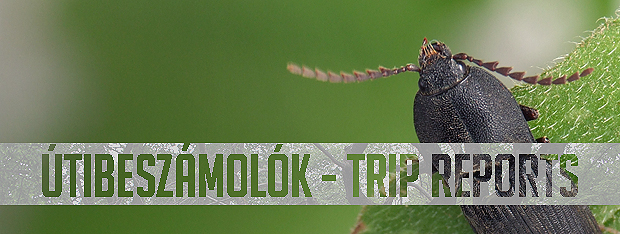
TRIP REPORTS
25. May - 9. June 2010, Syria
Translation by Emese Jókuthy.
This year I and three of my friends
had planned to travel abroad together. While Attila Kotán and
Nikola Rahmé had both been in Syria before, it was the first
time that Edvárd Mizsei and I visited the Middle East. We
decided to go there from 25 May to 9 June. The tickets were purchased
earlier this year and the itinerary had been agreed upon later. Each of
us packed 30kg of collecting equipments, tent, camera accessories,
canned food and as few clothes as possible. Other reports from this
trip see: http://buprestidae.blogspot.com/
and http://herpetography.com/?paged=2
Our plane landed around 3 a.m. at the
airport of Damascus. We rented a car, packed in and set off for our
first destination, Bloudan that could be reached in one and a half
hours. We arrived just after the sun had risen. Although we had been
awake all night, we just had a quick snack, changed clothes and set to
work at once.
The
first longhorn beetle Attila found was Phytoecia kabateki that has only
been known to science for fourteen years. The ca. 1 cm long beetles
were found on blooming Ferula hermonis. We managed to observe a dozen
of them while they were feeding and mating.
There were some enormous darkling beetles crawling around on the rocky ground (Blaps cribrosa).
A jewel beetle (Sphenoptera sp.).
It was not an easy task to find a place on the rocky surface to put up our tents.
This longhorn beetle was attracted by the UV light trap. Some friends of mine have also caught some specimens of this Neoplocaederus species here in the past few years. This beetle species new to science was described by Attila and Dr. Gianfranco Sama, who named it Neoplocaederus laszlokotani after Attila’s father.
Walking around almost 2000 meters high in the bright sun and clean air.

A common Stellion (Laudakia stellio).
A source of drinking water near an irrigation canal supplying a nearby fruit plantation. (photo: N. Rahmé Nikola)
Just like a phalanstère.
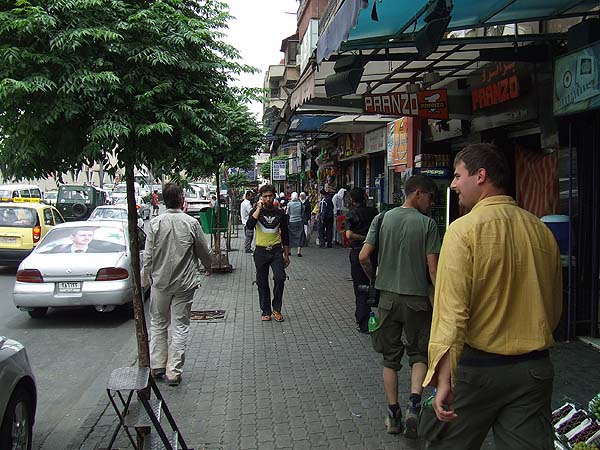
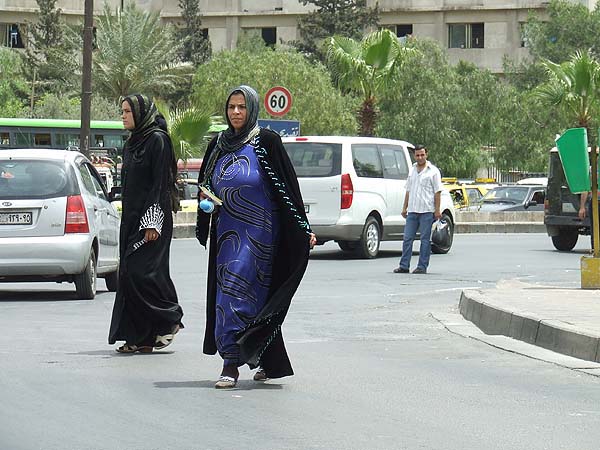

(photo: E. Mizsei)
After a day in Bloudan we set off for our next destination, the desert in the East.
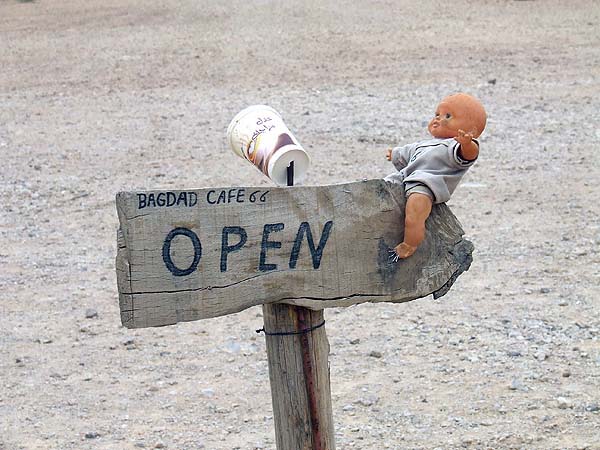
We drove across the desert sometimes
reaching 160km/h. The intense heat was intolerable even with windows
rolled down. Moreover, we could hardly stand the constantly blowing and
burning desert wind carrying grains of sand. We made a brief halt in a
small cafe in the middle of nowhere.
A huge jewel beetle walking in the parking lot (Julodis syriaca distincta).
We ended up in Palmyra at last. We
found accommodation in an oasis outside the city
and spent the next two days there thanks to the kind invitation of the owner of the land.
and spent the next two days there thanks to the kind invitation of the owner of the land.
Looking for beetles in the sultry sun. (photo: N. Rahmé)

(photo: A. Kotán )
This lovely jewel beetle (Sphenoptera scovitzi) lives on mimosa trees.
(photo: N. Rahmé)
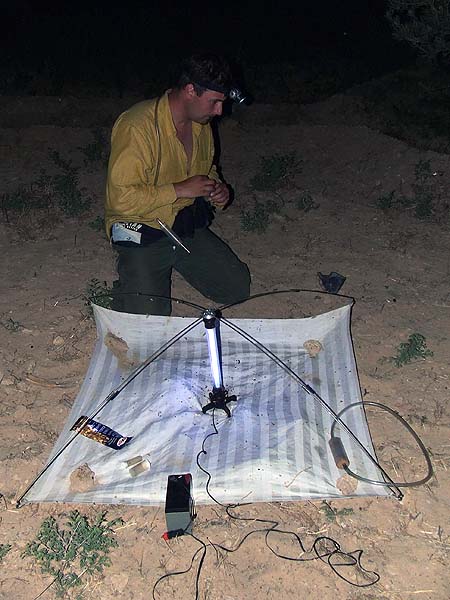
Light traps attracted a surprising amount of beetles. We spent all the night wandering back
and forth between two light traps placed distant from one another, and gathering the tiny beetles.
A small click beetle species, Aeoloderma crucifer.
The click beetle Cardiophorus pharaonum.
Drasterius bimaculatus, also living in Hungary.
A darkling beetle resembling the fruit of elm (Cossyphus tauricus).
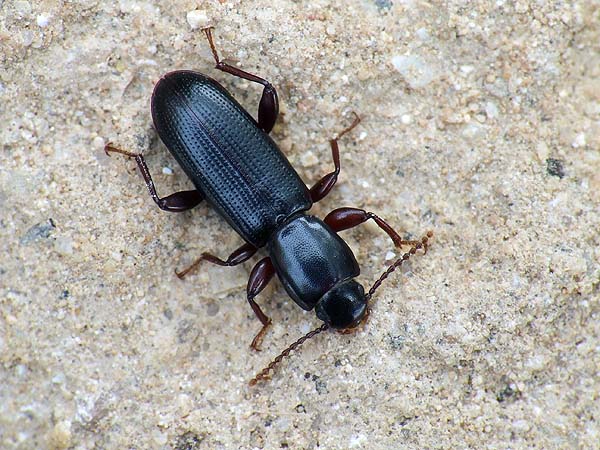
Another darkling beetle Centorus heydeni.
Specimens of Scarites sp. were on the lookout for prey on the dunes at
night: Scarites
procerus
eurytus.
These two darkling beetles were crawling on the sand at night:
Scaurus puncticollis.
Blaps judaeorum.
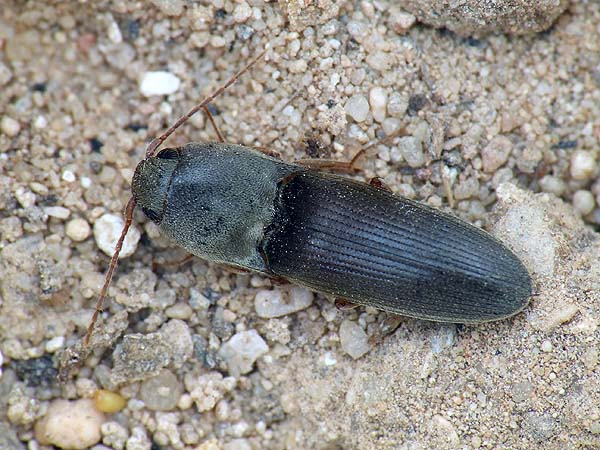
A click beetle also attracted to light Aeoloides grisescen.
Next day we were wandering in the desert for some hours.
There are some ancient pistachio trees an hour drive from Palmyra, in the middle of nowhere.

(photo: A. Kotán)

Water reservoir with stench in the air.
A horse agonizing in the bushes on the coast.
A tiny darkling beetle from under a rock (Adelostoma sulcatum).
The ruins of Palmyra bear witness to the civilisation that once flourished there.
Scarabaeus sp.
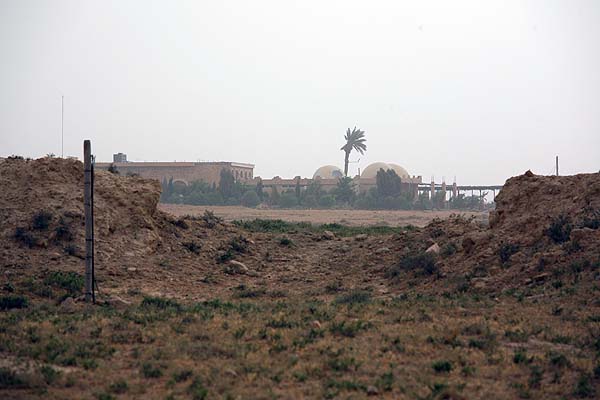
(photo: N. Rahmé)
Fed up with the desert, we started to make our way eastward to the city of Deir Ez Zor on the Euphrates River.
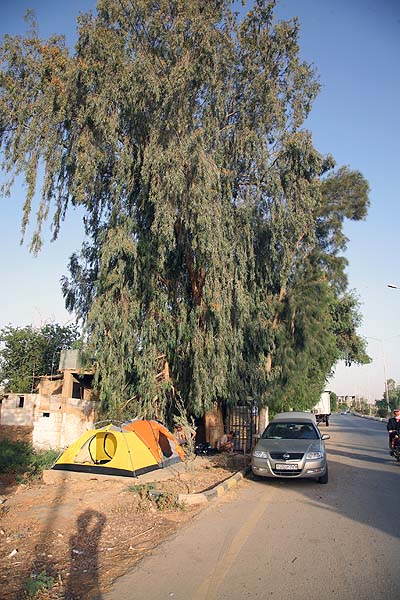
We camped on an empty plot just next to the road outside the city. (photo: N. Rahmé )
As the Euphrates was close, we could get rid of the dust gained through the travel.
Tiny mullets were pinching our feet in the fast flowing, shallow river.
At dusk larger eel-like fish appeared and showed off on the gravel bottom.
After some clumsy trial we managed to catch one (photo: N. Rahmé)
The makeshift pool helped us take photos of the spiny eel (Mastacembelus mastacembelus).
Next day, we walked the streets in the sultry heat to chase jewel beetles (Psiloptera argentata)
flying around trees and shrubs.
The jewel beetle Chalcophorella bagdadensis, 4cm in length, develops in poplar trees of the riverside
In the evening, some gentle sounds of
movement in the leaf litter drew our attention to some female longhorn
beetles (Prionus coriarius)
harassed by horny males. The giant females swollen with eggs are
usually sitting around right under the trees, while the smaller males
with flabellate antennae are running and flittering around in search of
them.
It was such a delight for Attila to find lots of specimens of Prionus lefebvrei.
Darkling beetles (Akis trilineata) were also found at night.
Gonocephalum sp.
On a recently burned beach there were several species of jewel beetles on poplar logs still smoking.
The most interesting one of them was Melanophila cuspidata that turned out to be new
even to our jewel beetle-expert friend, Nikola.
At night a long-eared hedgehog (Hemiechinus auritus) presented itself by our light.

Although I’m not a bird photographer, I managed to record this blue-cheeked bee-eater (Merops persicus)
Next evening we set up camp next to a small islamic shrine near the Turkish border, knee-high in litter.
This common chameleon (Chamaeleon chamaeleon) was caught at night while it was sleeping.
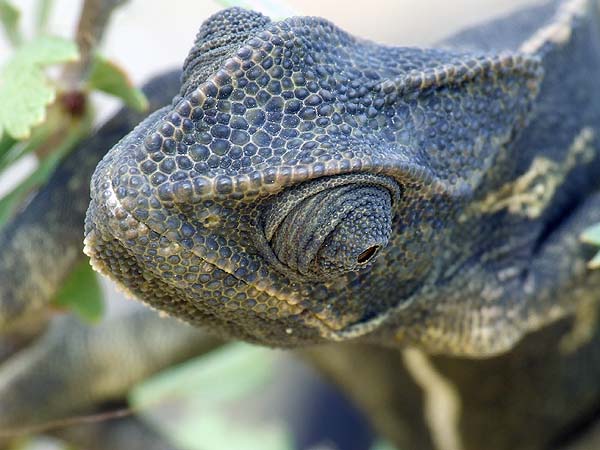
Nearby was a foul-smelling little creek. There were different jewel beetles species flittering around the elm trees growing on the creek bank. They could easily be caught with a long-handled sweep net.
Chalcophorella quadrioculata.
Lamprodila gloriosa.
Metallic green and blue jewel beetles (Polyctesis rhois) were flittering around in the thick grove of sumac.
Six Capnodis species were caught on trees and herbs during the trip, including this Capnodis porosa.
We made our way to the sea along the northern border of the country.
Algerian orange-tailed skink (Eumeces algeriensis).
Galbella felix – An odd shaped jewel beetle.
This click-beetle was attracted by the UV light trap. This beetle species new to science was described by Giuseppe Platia and me, who named it Agriotes rahmei, after my friend Nikola Rahmé.
Melanotus sp.
At last we reached the sea at the Turkish border and had the chance to get rid of the dirt.
(photo: N. Rahmé Nikola)
We spent the night in an abandoned stone quarry.
Jewel beetles and longhorns were sitting on the yellow flowers in the evening: Anthaxia sponsa.
Stenopterus rufus syriacus.
We were lucky enough to catch some more interesting species. Showy click beetles were sheltered in the flowers of thistles growing on seashores Cardiophorus sacratus.
Metallic longhorn beetles were flittering around the plants on the shore: Helladia millefolii.
Women in swimming suit.

Trichofeus kotschyi emerged from branches, collected by Attila.
It was certainly worthwhile to look at some woodpiles in the neighbourhood of Kasab.
Giant net-winged beetle (Lycostomus sp.)
The darkling beetle Menephilus cylindricus found under bark.
This click beetle (Lacon punctatus) was also found under bark.
The jewel beetle Buprestis dalmatinus.
A huge click beetle Calais parreysi...
...and its larva.
While looking around in the neighbouring forests we found a plant on which
a unique species of longhorn beetles feed. .
Pygoptosia speciosa, a male...
...and a female Pygoptosia speciosa
Descending into a valley carved by water we could find damper habitats.
Ampedus phoenicium
The darkling beetle Raiboscelis syriacus.
Specimens of the longhorn beetle Niphona picticornis were knocked down from dry twigs.
Blepisanis vittipennis.
We stopped then not far from Slunfeh, where, sweltering in the desert heat for hours,
we were sweeping the oak shrubs hoping for beetles.
Sweeping the shaded side of the trees resulted in a considerable amount of beetles, for example this click beetle (Cardiophorus kindermanni).

Sizeable jewel beetles (Perotis chlorana) were flying around above the oak bushes in the sweltering heat
Protaetia speciosa jousselini resembling a gemstone.
Longhorn beetles (Plagionotus bobelayei) were seen on the flower buds of tree-mallows growing up to 3m tall.
Another click beetle (Cardiophorus vestigialis) on the shrub oak.
The longhorn beetle Saperda quercus ocellata was a real find.
Both Edvárd and Nikola were keen on capturing and taking photos of a Levant viper (Macrovipera lebetina) . After a long search we finally found the hiding place of a sizeable male, and together we managed to catch it.
Photographing was followed by thorough data recording.
We measured length and weight, counted the scales and drawn DNA samples, which took a little time.
Another snake species, the harmless large whip snake (Dolichophis jugularis).
Eirenis sp.
Bee beetle, Trichodes sp.
The flower chafer Cetonia delagrangei.

(photo: A. Kotán)

(photo: A. Kotán)
In the closed and damp forest of Slunfeh we finally had the opportunity to pull apart rotten logs
and sift the wood mould to see what we found.
This Ampedus phoenicium was found on a rotten log.
Hypoganus
(photo: N. Rahmé)
The next destination was the castle of Salah Addin. There are enormous oaks providing habitat for many beetles.

Huge specimens of the longhorn beetle Cerambyx welensii were running around on the oak trees at night.
Larger males may reach more than 6cm in length
Taking a decaying log apart you can find many different larval tunnels.
A rare jewel beetle, Latipalpis plana develops on kermes oak (Quercus coccifera).
Latipalpis plana.
Following the trails of longhorn beetles in the hardwood, we were expecting to find some larvae. To our surprise there were no longhorn larvae present in the pupal chamber but, as their predators, click beetle (Tetrigus cyprius) larvae and pupae ready to metamorphose. Adult specimens of this click beetle can reach a length of 5 cm. (photo: N. Rahmé)
(photo: N. Rahmé)
(photo: N. Rahmé)
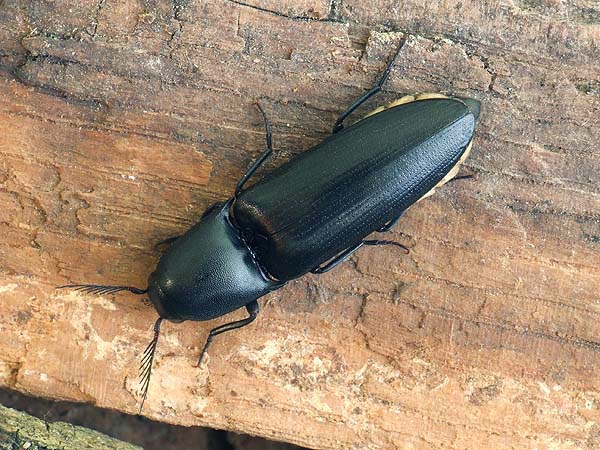
Weeks later beetles emerged from the pupae.
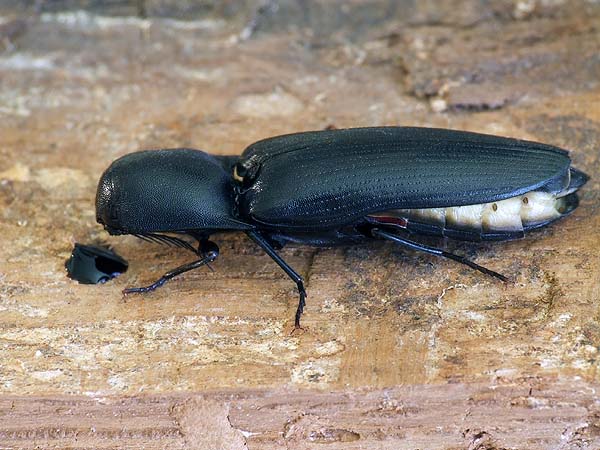
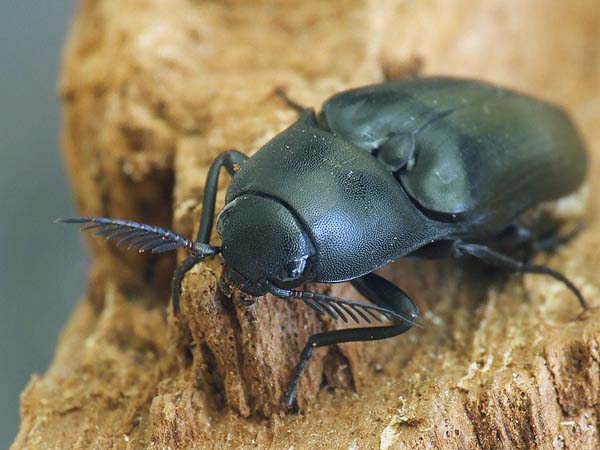
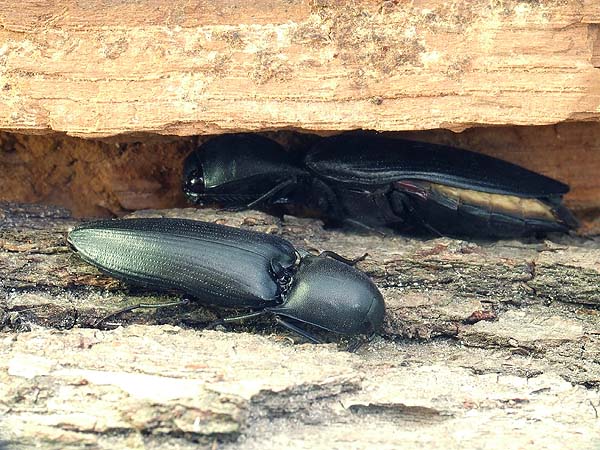
Females are much bigger, than males.
After dark, while wandering among the ruins with flashlights, many beetles were found on the oak trees.
Straight-snouted weevil (Amorphocephala coronata).
Powderpost beetle Lichenophanes numida.
Dastarcus libanicus.
Male of a darkling beetle Cryphaeus laticeps.
The darkling beetle Metaclisa azurea.
Next evening the tents were put up in an ash grove. We spent the night looking for beetles with flashlight in the gale.
A pair of this click beetle was found: Pittonotus simoni.
Specimens of Prionus lefebvrei were caught at the roots of some old ash trees.
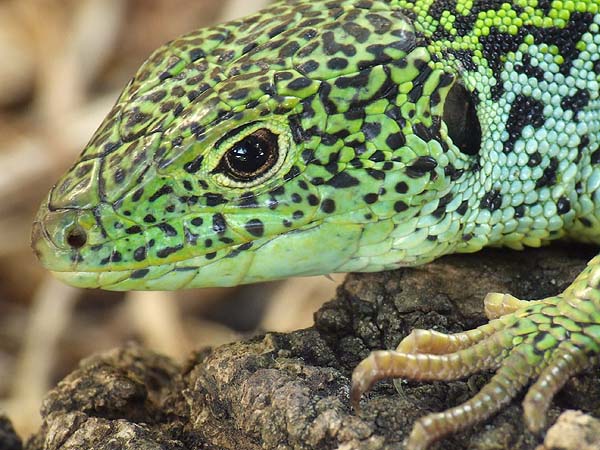
A female Levant green lizard Lacerta media.
(photo: N.Rahmé)
We spent the last night at the fortress of Krak des Chevaliers. We stayed there for a while to pull ourselves together.
We couldn’t help looking around in the neighbourhood of the one-star hotel, and a specimen of Julodis andreae was found..
Our plane took off at 4 a.m., so we had some time left to explore the city.
Under the pretext of purchasing souvenirs we visited the bazaar shops where we were faced by such exciting things like modest bras and pants..
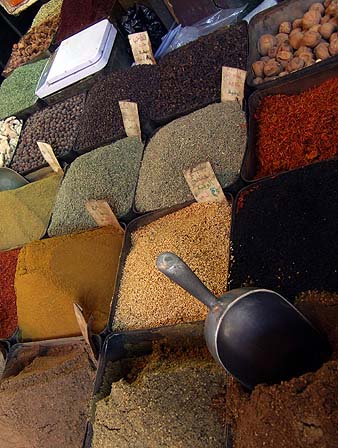
We spent 14 days and travelled some
3000kms in Syria. We have been to deserts, mountainous conifer forests,
rocky seashores and on the banks of mighty rivers. However, travelling
so much was sometimes extremely exhausting and we had to work really
hard to get results. More than 3000 beetles were collected, the bulk of
which is to be deposited in the Coleoptera Collection of the Hungarian
Natural History Museum. Local people were all very kind and hospitable,
either in a crowded city or in a sparsely populated seminatural
habitat. We were offered tea wherever we stayed. Their natural
curiosity, that was never intrusive, really impressed us. Sometimes we
had some trouble with the official bodies. Fortunately, Nikola speaking
fluent Arabic could help us out. His Arabic was essential during the
whole trip anyway.
This was the first time I have been to Syria and it was by far the greatest experience I have ever had. Thank you, Syria!
This was the first time I have been to Syria and it was by far the greatest experience I have ever had. Thank you, Syria!
Copyright
©
2009. Hungarian Natural History Museum,
Department of Zoology, Coleoptera Collection